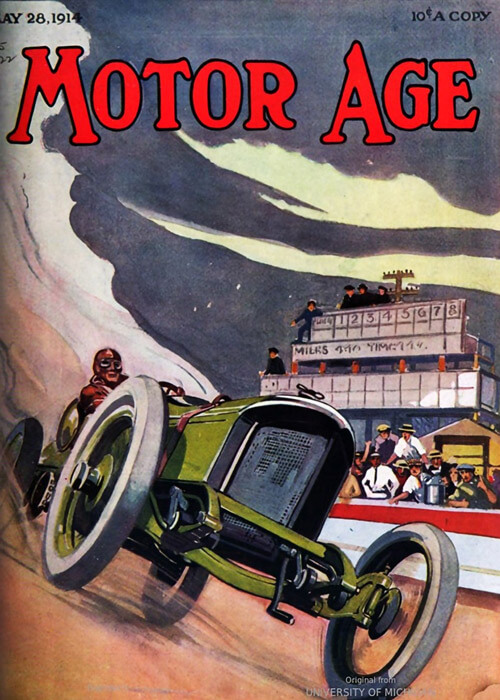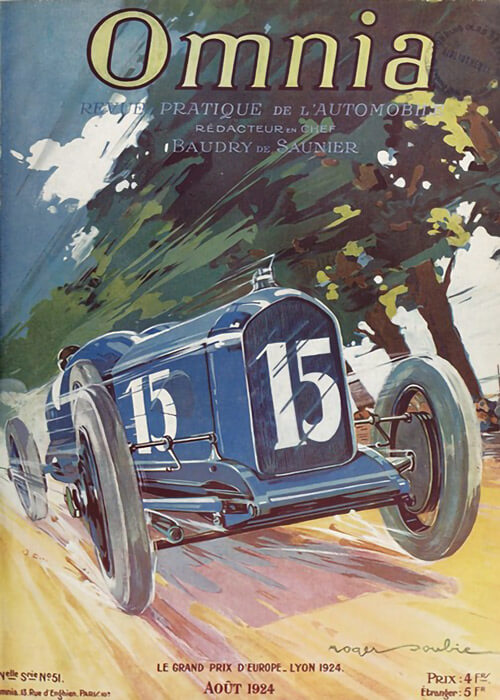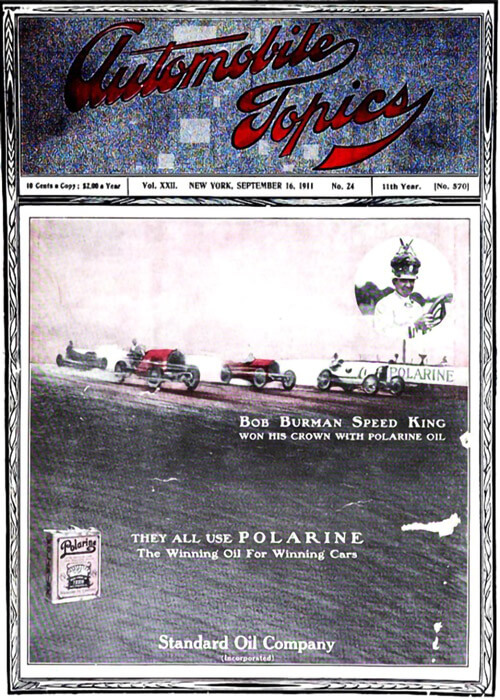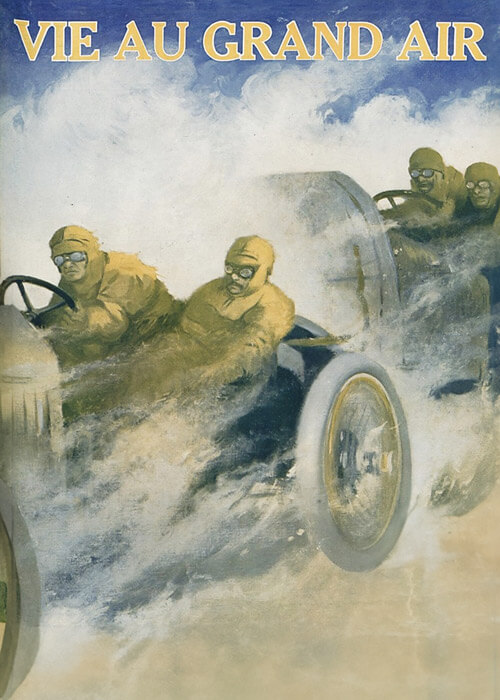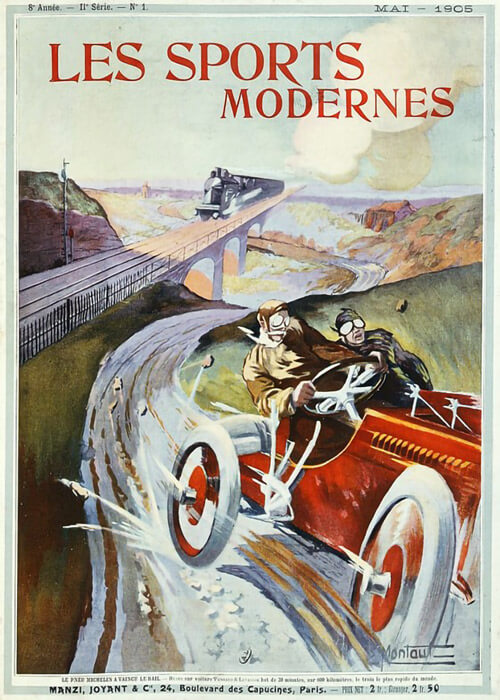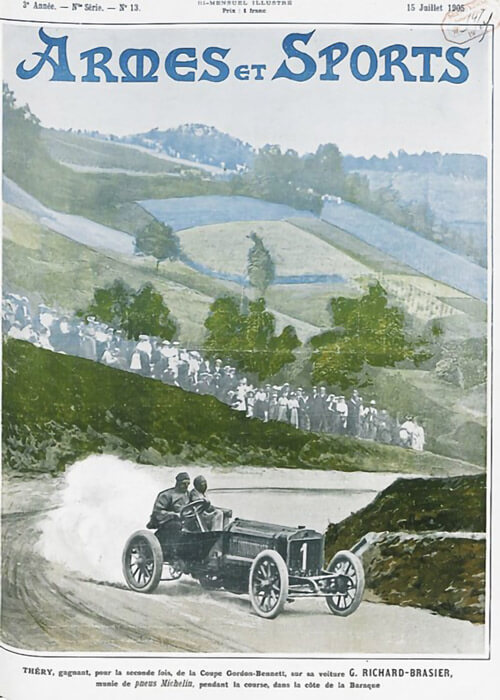


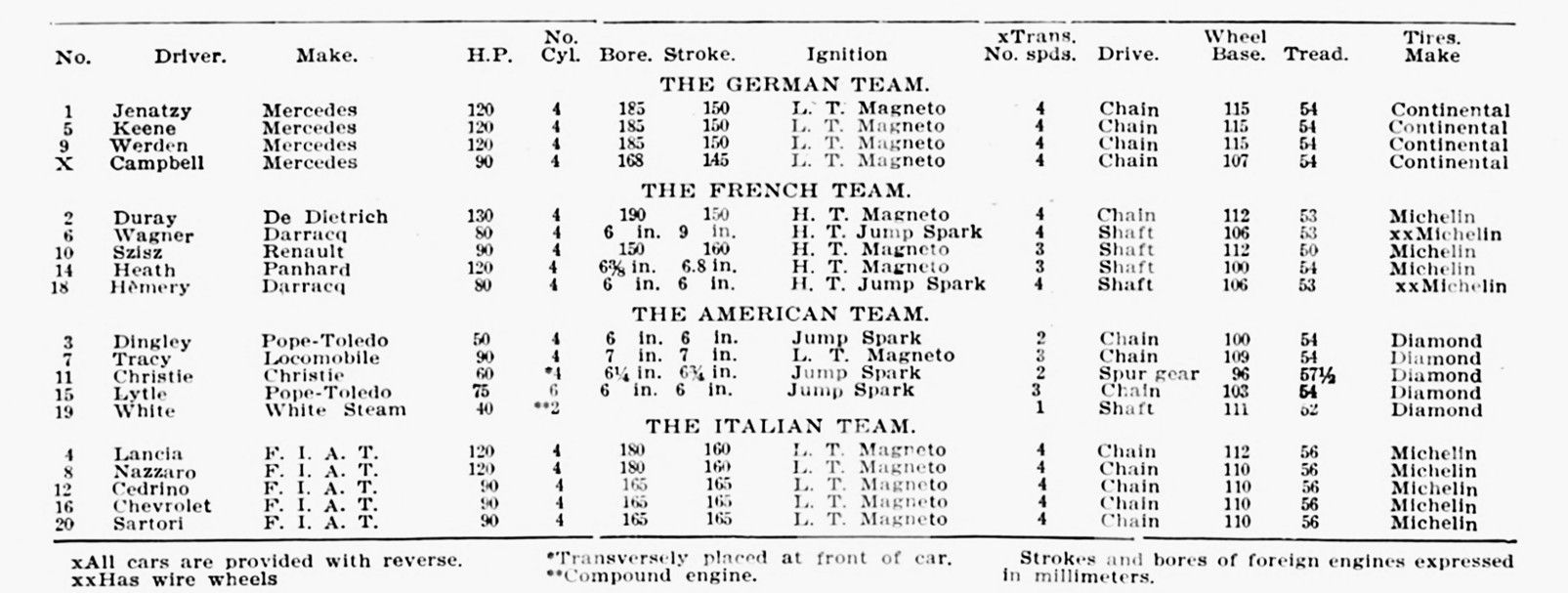
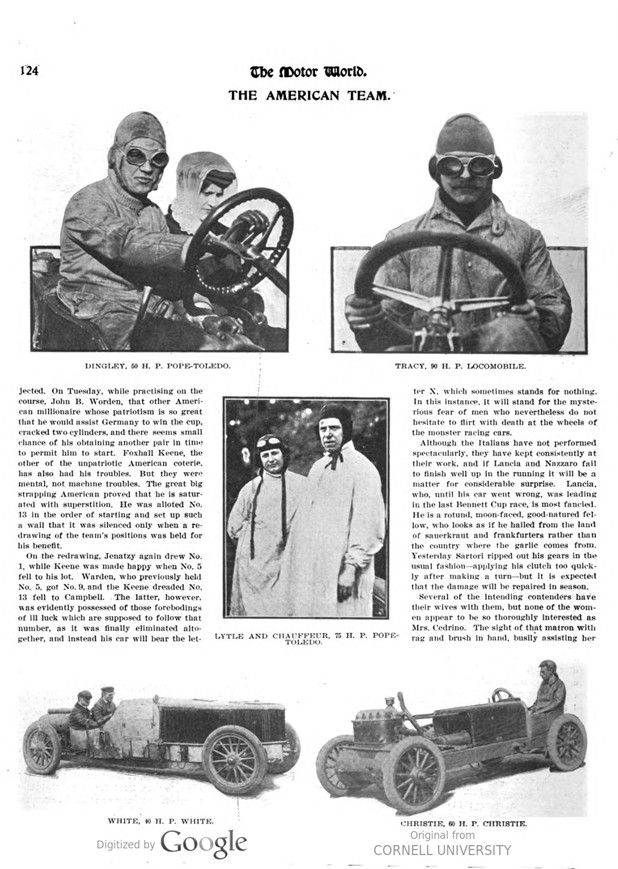
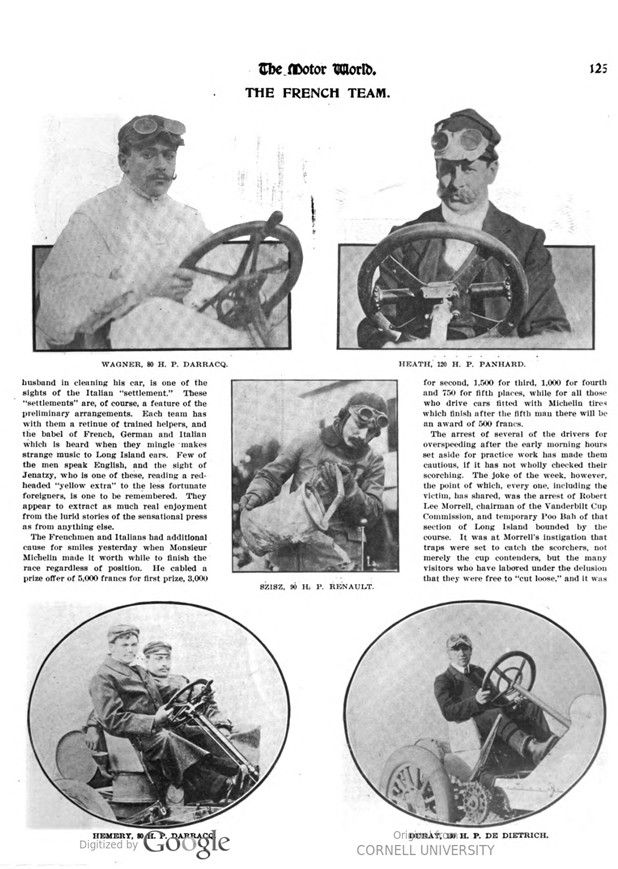
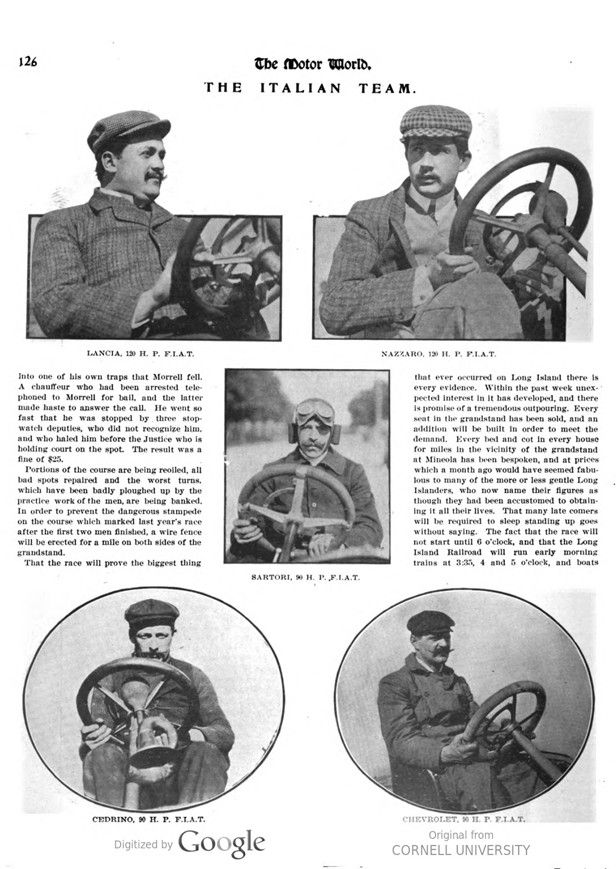

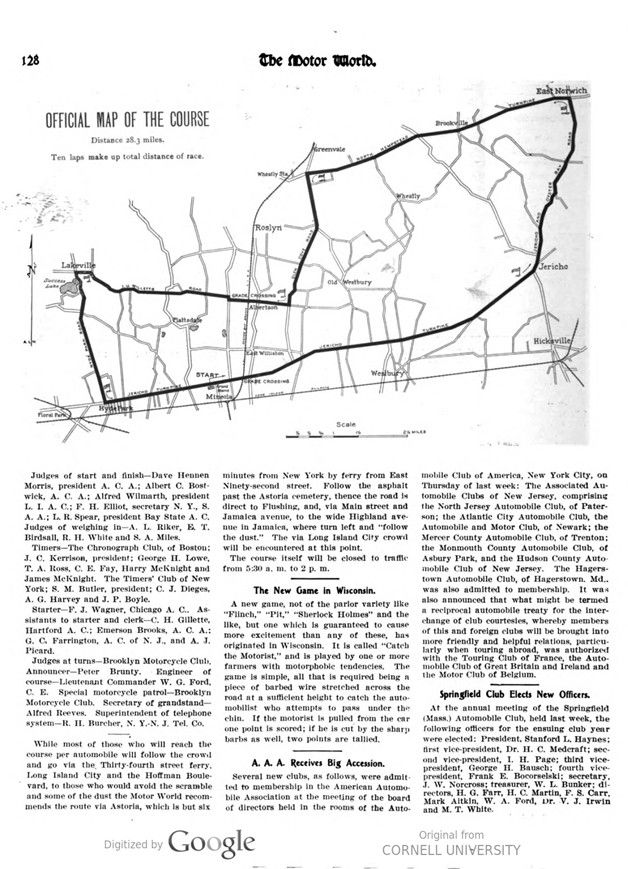
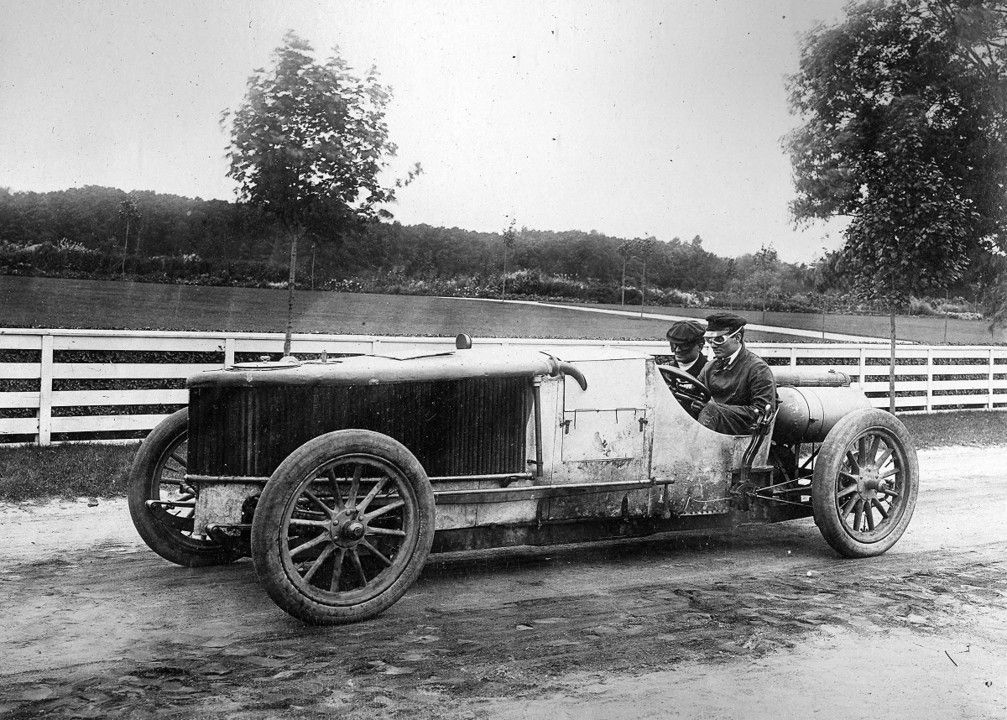




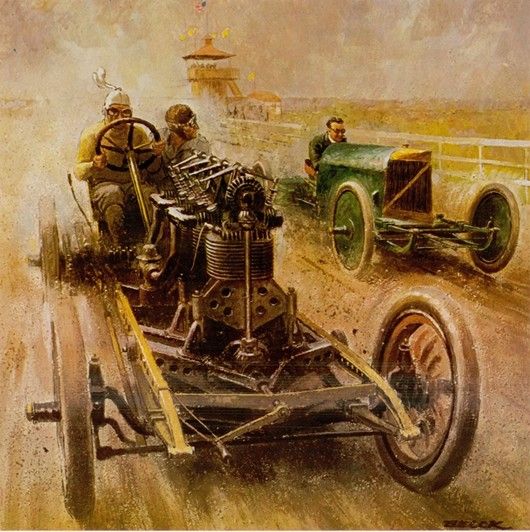
Text and pictures with courtesy of Hathitrust.org; compiled by motorracinghistory
The Motor World, Vol. XI, No. 3, October 12, 1905; pages 123 – 128
READY FOR BIG RACE
All Arrangements Complete and Enormous Outpouring Indicated
Keene Dodges No. 13 but III Luck Pursues German Team
Practice Work Promises Fastest Race Ever Run.
Given dry roads, it is evident that the man and car that win the Vanderbilt Cup in the 283-mile race over Long Island roads on Saturday next, the 14th inst., will have averaged very much better than 60 miles an hour. This fact is made plain by the performances of the men who have deported themselves on the course during the past week. Their work is limited to the early morning hours, previous to 7:30 o’clock, and „holding watches“ on them has been the favorite pastime of all who are most vitally concerned in the result.
THE ORDER OF STARTING.
Start, 6 a.m., at one minute intervals. – Distance, 283 miles; per lap, 28.3 miles.
These „railbirds“ have clocked 60 miles an hour or over so often that it is too common to excite remark. There are tales of one round of the pipe-shaped circuit of 283-10 miles in slightly more than 21 minutes, or about 80 miles an hour, by Hemery, of the French team. This speed, however, seems impossible and is generally doubted. Apparently, the best authenticated lap was negotiated by Szisz (pronounced „Cease“), also of France, who is credited with 23 minutes, 30 seconds. Three watches are said to have recorded this performance. Szisz has also been timed four circuits, 113.2 miles, in 106 minutes. Nearly all of the other foreigners have also made some remarkable flights. They are a skillful, daredevil lot.
Only the Americans appear not to have let themselves out, or at any rate the „railbirds“ have not placed any startling performances to their credit. The general impression is that they stand small chance of victory. Walter White, in the powerful White steamer, who appeared the most likely one to turn the trick, has been doing a lot of dawdling on the course, but seems too cautious to do the turning. As one of his adherents expressed it, „I am afraid Walter is too much of a gentleman for this sort of thing.“ Walter Christie has offered the one ray of hope. With one of his four cylinders out of commission, he trailed Wagner, in the big Darracq for three laps, covered in 1:18:36,1 or at the rate of 65 miles per hour. Christie’s car is, however, a terror on tires, and even if it has the speed tire troubles or its rubber ball action is expected to give him his quietus.
The German team has already been badly crippled, making it appear that if the red-haired Jenatzy does not show prominently a victory for either France or Italy is practically certain. Germany has indeed been in hard luck. Of the four Americans and one Belgian who comprise its team, two of the former are already out of it, and owing to the non-arrival of Clarence Gray Dinsmore’s Mercedes it was necessary to impress a substitute, the power of which is in no way equal to that of its mates.
When Baron de Cater’s withdrawal from the team was announced, S. B. Stevens, of Rome, N. Y., promptly filled the breach. He offered his Mercedes and his driver, A. L. Campbell, and they were accepted. Then Dinsmore’s car was reported not ready, and H. L. Bowden, of Boston, presented his car as a substitute. But it has been altered since it came from Germany and now incorporates some American parts. Accordingly, it was rejected. On Tuesday, while practising on the course, John B. Worden, that other American millionaire whose patriotism is so great that he would assist Germany to win the cup, cracked two cylinders, and there seems small chance of his obtaining another pair in time to permit him to start. Foxhall Keene, the other of the unpatriotic American coterie, has also had his troubles. But they were mental, not machine troubles. The great big strapping American proved that he is saturated with superstition. He was allotted No. 13 in the order of starting and set up such a wail that it was silenced only when a redrawing of the team’s positions was held for his benefit.
On the redrawing, Jenatzy again drew No. 1, while Keene was made happy when No. 5 fell to his lot. Warden, who previously held No. 5. got No. 9, and the Keene dreaded No. 13 fell to Campbell. The latter, however, was evidently possessed of those forebodings of ill luck which are supposed to follow that number, as it was finally eliminated altogether, and instead his car will bear the letter X, which sometimes stands for nothing. In this instance, it will stand for the mysterious fear of men who nevertheless do not hesitate to flirt with death at the wheels of the monster racing cars.
Although the Italians have not performed spectacularly, they have kept consistently at their work, and if Lancia and Nazzaro fail to finish well up in the running it will be a matter for considerable surprise. Lancia, who, until his car went wrong, was leading in the last Bennett Cup race, is most fancied. He is a rotund, moon-faced, good-natured fellow, who looks as if he hailed from the land of sauerkraut and frankfurters rather than the country where the garlic comes from. Yesterday Sartori ripped out his gears in the usual fashion – applying his clutch too quickly after making a turn – but it is expected that the damage will be repaired in season.
Several of the intending contenders have their wives with them, but none of the women appear to be so thoroughly interested as Mrs. Cedrino. The sight of that matron with rag and brush in hand, busily assisting her husband in cleaning his car, is one of the sights of the Italian „settlement.“ These „settlements“ are, of course, a feature of the preliminary arrangements. Each team has with them a retinue of trained helpers, and the babel of French, German and Italian which is heard when they mingle makes strange music to Long Island ears. Few of the men speak English, and the sight of Jenatzy, who is one of these, reading a red-headed „yellow extra“ to the less fortunate foreigners, is one to be remembered. They appear to extract as much real enjoyment from the lurid stories of the sensational press as from anything else. The Frenchmen and Italians had additional cause for smiles yesterday when Monsieur Michelin made it worthwhile to finish the race regardless of position. He cabled a prize offer of 5,000 francs for first prize, 3,000 for second, 1,500 for third, 1,000 for fourth and 750 for fifth places, while for all those who drive cars fitted with Michelin tires which finish after the fifth man there will be an award of 500 francs.
The arrest of several of the drivers for overspeeding after the early morning hours set aside for practice work has made them cautious, if it has not wholly checked their scorching. The joke of the week, however, the point of which, everyone, including the victim, has shared, was the arrest of Robert Lee Morrell, chairman of the Vanderbilt Cup Commission, and temporary Poo Bah of that section of Long Island bounded by the course. It was at Morrell’s instigation that traps were set to catch the scorchers, not merely the cup contenders, but the many visitors who have labored under the delusion that they were free to „cut loose,“ and it was into one of his own traps that Morrell fell. A chauffeur who had been arrested telephoned to Morrell for bail, and the latter made haste to answer the call. He went so fast that he was stopped by three stop- watch deputies, who did not recognize him, and who haled him before the Justice who is holding court on the spot. The result was a fine of $25.
Portions of the course are being reoiled, all bad spots repaired and the worst turns, which have been badly ploughed up by the practice work of the men, are being banked. In order to prevent the dangerous stampede on the course which marked last year’s race after the first two men finished, a wire fence will be erected for a mile on both sides of the grandstand.
That the race will prove the biggest thing that ever occurred on Long Island there is every evidence. Within the past week unexpected interest in it has developed, and there is promise of a tremendous outpouring. Every seat in the grandstand has been sold, and an addition will be built in order to meet the demand. Every bed and cot in every house for miles in the vicinity of the grandstand at Mineola has been bespoken, and at prices which a month ago would have seemed fabulous to many of the more or less gentle Long Islanders, who now name their figures as though they had been accustomed to obtaining it all their lives. That many late comers will be required to sleep standing up goes without saying. The fact that the race will not start until 6 o’clock, and that the Long Island Railroad will run early morning trains at 3:35, 4 and 5 o’clock, and boats every fifteen minutes, are the relieving features of the situation. It will enable many of the New Yorkers to snatch forty winks before departing for the scene of the contest. But only the clubmen, and those who are so fortunate as to be acquainted with them, will be in clover. The Automobile Club of America and the Long Island Automobile Club will have tents erected in which breakfast will be served, while the New York Motor Club has leased a cottage for the night and will do likewise.
—————
A casual study of the specifications of the machines which have been declared for the race reveals the interesting fact that among the twenty cars on the list but ten different makers are represented, the German and Italian teams being made up in each case of the cars of a single manufacturer, the Mercedes. in the first instance, and the Fiat in the second. The French and American teams have each two cars of a single make, the Darracq. in the first instance, and the Pope-Toledo, in the second, thus leaving but a single representative of the ancient and honorable house of Panhard; the Renault and the De Dietrich, for France, and on the American team only the Locomobile and the White as representatives of well-known houses.
In point of design the two makes of car which are best shown are quite alike down to the last detail, the Fiat being a Mercedes copy and in many ways a betterment of its prototype. In horsepower they are all rated at either 120 or 90; all are equipped with four-cylinder motors, cylinder volume being slightly in favor of the Mercedes in the 120 horsepower, and the Fiat in the case of the 90 horsepower cars. Both are equipped with the low tension system of ignition, with. make and break igniters, and both are chain driven. The Mercedes cars, however, have the longer wheel base in each case.
As to the salient features of the other cars, the horsepower varies from the 120 Panhard, which Heath is to drive, down to the 40 horsepower Waite, unique in more ways than one. Apparently among the French and American designers there is a leaning toward the jump spark method of ignition, for with the exception of the Locomobile all the cars on the two teams have one of the two high tension systems, the Frenchmen inclining toward the magneto and the Americans toward the accumulator. France exhibits but a single car having the chain drive, the De Dietrich, and America but one equipped with the shaft transmission, the method of double chain transmission holding in favor – with the builders of thirteen out of the total of twenty machines. As to wheelbase, the German cars have the greater length, with the Italians second, the shortest cars of all being on the American team.
In appearance the Christie, the White. Lytle’s Pope-Toledo, with its long bonnet; the beetlelike Renault and the Darracqs, with their wire wheels, are the only machines which are easily to be distinguished when running at speed. Heath’s Panhard has a square bonnet, to be sure, but so have the Darracqs, and when coming head on there is but little to show the difference between them, unless it be the heavy diapason of the Panhard motor.
Certain of the specifications of the competing cars will not be made public until the weighing in on Friday, notably the weights and tank capacities.
—————-
The following will be the officials of the contest:
Robert Lee Morrell, chairman. Referees – William K. Vanderbilt, Jr., A. R. Pardington, associate.
Judges of start and finish-Dave Hennen Morris, president A. C. A.; Albert C. Bost- wick, A. C. A.; Alfred Wilmarth, president L. I. A. C.; F. H. Elliot, secretary N. Y., S. A. A.; L. R. Spear, president Bay State A. C. Judges of weighing in-A. L. Riker, E. T. Birdsall, R. H. White and S. A. Miles.
Timers – The Chronograph Club, of Boston; J. C. Kerrison, president; George H. Lowe, T. A. Ross, C. E. Fay, Harry McKnight and James McKnight. The Timers‘ Club of New York; S. M. Butler, president; C. J. Dieges, A. G. Harvey and J. P. Boyle.
Starter – F. J. Wagner, Chicago A. C. Assistants to starter and clerk – C. H. Gillette, Hartford A. C.; Emerson Brooks, A. C. A.: G. C. Farrington, A. C. of N. J., and A. J. Picard.
Judges at turns – Brooklyn Motorcycle Club. Announcer – Peter Brunty. Engineer of course Lieutenant Commander W. G. Ford, C. E. Special motorcycle patrol – Brooklyn Motorcycle Club. Secretary of grandstand- Alfred Reeves. Superintendent of telephone system-R. H. Burcher, N. Y.-N. J. Tel. Co.
—————
While most of those who will reach the course per automobile will follow the crowd and go via the Thirty-fourth street ferry, Long Island City and the Hoffman Boulevard, to those who would avoid the scramble and some of the dust the Motor World recommends the route via Astoria, which is but six minutes from New York by ferry from East Ninety-second street. Follow the asphalt past the Astoria cemetery, thence the road is direct to Flushing, and, via Main street and Jamaica avenue, to the wide Highland avenue in Jamaica, where turn left and „follow the dust.“ The via Long Island City crowd will be encountered at this point.
The course itself will be closed to traffic from 5:30 a.m. to 2 p.m.
—————
Photo captions, pages 123 – 128.
AN AMERICAN AMUSES JENATZY.
THE AMERICAN TEAM.
DINGLEY, 50 H. P. POPE-TOLEDO. – TRACY, 90 H. P. LOCOMOBILE.
LYTLE AND CHAUFFEUR, 75 H. P. POPE-TOLEDO
WHITE, 40 H. P. WHITE. – CHRISTIE, 60 H. P. CHRISTIE.
THE FRENCH TEAM.
WAGNER, 80 H. P. DARRACQ. – HEATH, 120 H. P. PANHARD.
SZISZ, 90 H. P. RENAULT.
HEMERY, 80 H. P. DARRACQ. – DURAY, 130 H. P. DE DIETRICH.
THE ITALIAN TEAM.
LANCIA, 120 H. P. F.I.A.T. – NAZZARO, 120 H. P. F.I.A.T.
SARTORI, 90 H. P. F.I.A.T.
CEDRINO, 90 H. P. F.I.A.T. – CHEVROLET, 90 H. P. F.I.A.T.
REMAINS OF THE GERMAN TEAM.
JENATZY, 120 H. P. MERCEDES. – KEENE, 120 H. P. MERCEDES.
——
HOW MRS. CEDRINO HELPS HER HUSBAND,
OFFICIAL MAP OF THE COURSE. The Motor World, page 128.
Distance 28.3 miles. Ten laps make up total distance of race.
Lakeville – Success Lake – HYDE PARK ROAD – Wheatly Sta – Roslyn – WILLETTS ROAD – GRADE CROSSING – Albertson – Plattsdale – START – JERICHO TURN PIKE – Floral Park Hyd COVE ROAD – East Williston – JERICHO Greenvale NORTH HEMPSTEAD – Old Westbury – Grand Stand – Mineola – GRADE CROSSING – Westbury – RAILROAD LONG ISLAND – Wheatly – TURNPIKE – Brookville – East Norwich – JERICHO AND OYSTER BAY ROAD – Jericho – Hicksville
The Motor World. Vol. XI, No. 3, October 12, 1905. Advertisement on page 161. (the car Carl Fischer was supposed to drive).
Taken ten days before the Eliminating Trials.
The Premier Vanderbilt Cup Racer will not compete in the finals for the simple reason that the Racing Board – as their chairman admits – refused to consider it in selecting the team to represent America.
This car was finished and subjected to more than 500 miles of road and speed tests before the date of the eliminating trials. However, it was overweight by about 100 pounds. We inquired if we could enter the eliminating trials, agreeing to reduce the weight later in such a way as would satisfy the committee that we had not sacrificed the reliability of the car, and agreed that we would abide by their decision. We were advised that we could not do this, and accepted the decision without a murmur, but immediately set about to reduce the car to the proper weight.
Monday, after the eliminating trials, we were advised that three of the only five cars which finished in the trials, would be dropped out, which would necessitate filling the created vacancies with cars which for some reason had failed to qualify in the elimination trials. If the eliminating trials meant anything, we consider that, the five cars which finished should be allowed to compete in the finals. Since the failure of the committee to take this view (as evidenced by their decision) created three vacancies, which, if filled, must of necessity include three cars which for some reason failed to quality, we could not see that only a failure on our part to weigh in originally, should eliminate us from further consideration, any more than the failure of other cars to finish after they had started in the contest.
On Monday following the Elimination Trials, we wired the committee that our car could weigh in, and offered it subject to any tests they might designate. We were advised by the chairman that „We were compelled to select the team without reference to your car.“ IS THIS AMERICAN SPORTSMANSHIP?
PREMIER MOTOR MANUFACTURING CO.,
No. 212 SHELBY STREET, – INDIANAPOLIS, IND. Members American Motor Car Manufacturers Association.
